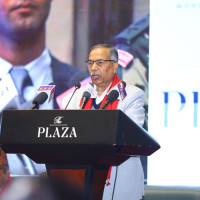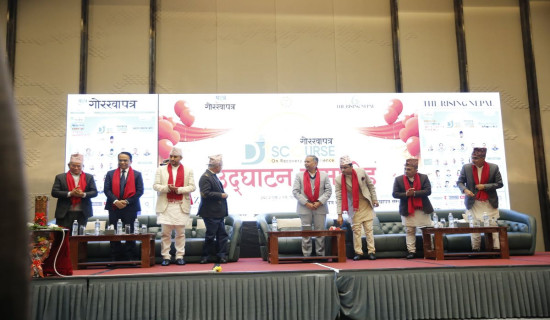- Friday, 19 December 2025
Teej: Mix Of Tradition And Aesthetics
Teej, or Haritalika Teej, is an ancient and holy festival for Sanatani Hindus, primarily from Nepal. With its roots in the Shiva Sampradaya and Himalayan culture, Teej is a special festival for ladies, celebrated with love and affection. The festival has the aura of strength, love, and wedded bliss. It is when Hindu ladies fast, worship Lord Shiva, and express their emotions with song and dance.
The origin of Teej carries rich legendary, cultural, and spiritual significance. According to the ancient Hindu scripture, the Bhavishyottar Purana, the story behind the Teej festival revolves around Goddess Parvati and her father, King Himalaya. Himalaya initially agreed when Sage Narada proposed Parvati's marriage to Lord Vishnu. Yet, Parvati's heart longed solely for Lord Shiva. Although she hesitated to reveal her desire to her father, she confided in her best friends.
Under her instruction, they took her to a remote cave by a riverbank, and Parvati observed a strict fast, praying with all sincerity to win Shiva's hand in marriage. Moved by Parvati's gravity and self-sacrifice, Himalaya accepted and granted her genuine desire, irrespective of his previous pledge to Sage Narada. Though breaking his word was difficult and carried social repercussions, Himalaya blessed Parvati's union with Lord Shiva.
This sacred marriage is commemorated through the festival of Haritalika Teej, symbolising Parvati's unwavering faith and the joyous fulfilment of her heartfelt wish.
Her fasting, known as Nirahar Vrat, represented perseverance, divine love, and feminine power—ideals celebrated through Teej. Her myth still evokes piety and honours the sacred marriage of the holy pair, thereby transforming Teej into a beautiful and spiritually rich festival.
From time immemorial, traditionally, Teej has been celebrated and firmly embedded in Nepali Hindu society's social and religious life. It is culturally about worshipping, praying, and fasting as per the behest of sacred scriptures. In this festival, wedded daughters return to their parents' homes for the Dar programme and Teej festivities. The married sisters are typically invited home by their brothers for the celebration. A day before Teej, all those families observing the festival conduct a dar, where the families enjoy delicious milk-based food items. On the day of Teej, the women observe nirahar vrata—fasting in imitation of the Himalayan Goddess Parvati.
They go on pilgrimages to Shiva temples to worship and pray. Women sing songs expressing their happiness and sorrows amidst the temple premises, creating an atmosphere of shared sentiment and festivity. Teej provides women a platform to strengthen relationships and restore family connections. Apart from celebrating long marital lives and wealth, Teej provides a space for women to relax, socialise, and express culture.
The Teej festival style is luxurious and very symbolic. Red is the colour that dominates the festival—women wear red saris, bangles, and sindur (vermilion), all of which represent love, fertility, passion, and wealth in Hindu society. The colour domination is intended to reinforce the festival's theme of devotion and harmony. Shiva temples with red and yellow lights, flags, and flowers offer a holy and festive atmosphere. Through music and dance, especially of married women, shared joy is represented, reinforcing community identity. These artistic elements are an impromptu celebration. They are also a representation of the people's culture and spiritual beliefs.
Most importantly, Teej transcends national boundaries and is celebrated by the Nepali diaspora community worldwide. In the Kathmandu Valley or far-off foreign cities, the festival always brings Nepali women together in yellow and red saris, singing and dancing, and reaffirming their loyalty to culture and tradition. The global celebration reiterates the enduring human need for belongingness, attachment, and identity through ritual—an example of the cultural diversity typical of Teej.
But Teej celebrations today are evolving, frequently crossing the old socialisation boundaries to add new patterns. Pre-Teej celebrations often focus on eating and partying, a departure from the traditionally sombre nature of the festival. Even the Dar programme, long defined by light milk-based beverages, has occasionally turned into parties with liquor—a shift that some feel cheapens the festival's sacredness and spiritual emphasis.
This transformation results from broader social forces such as globalisation and modern entertainment forces that can overcome Teej's inner values. Throughout the month-long festivities, piety becomes entertainment, and this can erode the cultural and religious tradition of Teej, especially among the youth.
Teej is far greater than fasting, singing, and dancing. It is a living tradition shaped by history, culture, and social practices. It gives women a vital space to reclaim themselves and share mutual empowerment in a patriarchal society. The festival celebrations are not shallow but inclusive, inviting those who attend to be drawn into a shared narrative of culture that affirms tradition and belonging. Despite modern challenges that may blur Teej's importance, it is worth remembering that it began with devotion, cultural connection, and love—the constant soul of Nepali Hindu life.
(PhD holder Gautam is a lecturer at Tribhuvan University.)















